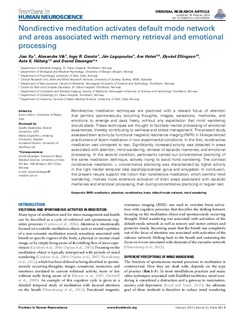| dc.contributor.author | Xu, Jian | |
| dc.contributor.author | Vik, Alexandra | |
| dc.contributor.author | Groote, Inge Rasmus | |
| dc.contributor.author | Lagopoulos, Jim | |
| dc.contributor.author | Holen, Are | |
| dc.contributor.author | Ellingsen, Øyvind | |
| dc.contributor.author | Håberg, Asta | |
| dc.contributor.author | Davanger, Svend | |
| dc.date.accessioned | 2015-07-28T08:32:14Z | |
| dc.date.accessioned | 2015-09-03T08:36:39Z | |
| dc.date.available | 2015-07-28T08:32:14Z | |
| dc.date.available | 2015-09-03T08:36:39Z | |
| dc.date.issued | 2014 | |
| dc.identifier.citation | Frontiers in Human Neuroscience 2014, 8(86) | nb_NO |
| dc.identifier.issn | 1662-5161 | |
| dc.identifier.uri | http://hdl.handle.net/11250/298536 | |
| dc.description.abstract | Nondirective meditation techniques are practiced with a relaxed focus of attention that permits spontaneously occurring thoughts, images, sensations, memories, and emotions to emerge and pass freely, without any expectation that mind wandering should abate. These techniques are thought to facilitate mental processing of emotional experiences, thereby contributing to wellness and stress management. The present study assessed brain activity by functional magnetic resonance imaging (fMRI) in 14 experienced practitioners of Acem meditation in two experimental conditions. In the first, nondirective meditation was compared to rest. Significantly increased activity was detected in areas associated with attention, mind wandering, retrieval of episodic memories, and emotional processing. In the second condition, participants carried out concentrative practicing of the same meditation technique, actively trying to avoid mind wandering. The contrast nondirective meditation > concentrative practicing was characterized by higher activity in the right medial temporal lobe (parahippocampal gyrus and amygdala). In conclusion, the present results support the notion that nondirective meditation, which permits mind wandering, involves more extensive activation of brain areas associated with episodic memories and emotional processing, than during concentrative practicing or regular rest. | nb_NO |
| dc.language.iso | eng | nb_NO |
| dc.publisher | Frontiers | nb_NO |
| dc.relation.uri | http://journal.frontiersin.org/Journal/10.3389/fnhum.2014.00086/full | |
| dc.title | Nondirective meditation activates default mode network and areas associated with memory retrieval and emotional processing | nb_NO |
| dc.type | Journal article | nb_NO |
| dc.type | Peer reviewed | en_GB |
| dc.date.updated | 2015-07-28T08:32:14Z | |
| dc.subject.nsi | VDP::Medisinske fag: 700::Basale medisinske, odontologiske og veterinærmedisinske fag: 710::Human og veterinærmedisinsk fysiologi: 718 | nb_NO |
| dc.subject.nsi | VDP::Midical sciences: 700::Basic medical, dental and veterinary sciences: 710::Human and veterinary science physiology: 718 | nb_NO |
| dc.source.volume | 8 | nb_NO |
| dc.source.journal | Frontiers in Human Neuroscience | nb_NO |
| dc.source.issue | 86 | nb_NO |
| dc.identifier.doi | 10.3389/fnhum.2014.00086 | |
| dc.identifier.cristin | 1128280 | |
| dc.subject.keyword | FMRI / FMRI | |
| dc.subject.keyword | Hjerne / Brain | |
| dc.subject.keyword | Meditasjon / Meditation | |
| dc.description.localcode | Copyright © 2014 Xu, Vik, Groote, Lagopoulos, Holen, Ellingsen, Håberg and Davanger. This is an open-access article distributed under the terms of the Creative Commons Attribution License (CC BY). The use, distribution or reproduction in other forums is permitted, provided the original author(s) or licensor are credited and that the original publication in this journal is cited, in accordance with accepted academic practice. No use, distribution or reproduction is permitted which does not comply with these terms. | nb_NO |
